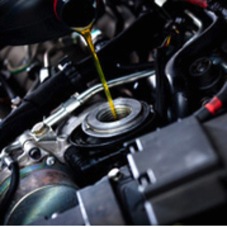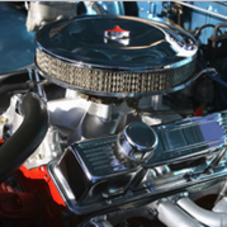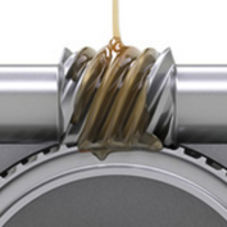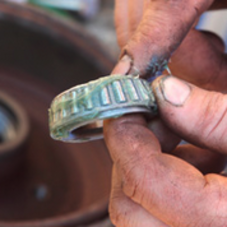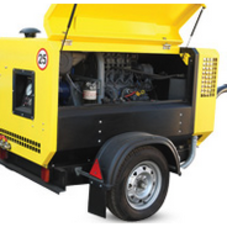AUTHORIZED DEALER
SELECT SYNTHETICS
Richard Rioux
referral # 5256323
(807) 853-0807

Motor Oil Viscosity Grades
The “SAE J300 Engine Oil Viscosity Classification” (EOVC)
In 1911 the Society of Automotive Engineers (SAE) created a numerical code graduated system - the SAE J300 Engine Oil Viscosity Classification - to classify motor oil according to their viscosity characteristics.
The SAE wanted a system that reflected the suitability of an oil for use as an engine lubricant and was easy for the consumer to understand. Before the SAE came up with the SAE J300 system, there was no simple way to tell how motor oil would behave in a hot engine.
Initially, the first version of the SAE J300 EOVC system defined five different numbered grades for motor oil (SAE 10, 20, 30, 40, and 50) based on flow rates (viscosities) measured at 100°C. By 1926 there were six grades of oil defined (SAE 10 through SAE 60).
Over the years, as shortcomings were identified, the SAE J300 system was amended numerous times. For instance, four SAE "W" (Winter) grades (SAE 10W, 15W, 20W, and 25W) were added in 1952, which were specified by viscosity measured at -18°C (0°F), as it became apparent that engines could not be started in very cold weather. Two more "W" grades (0W and 5W) would later be added.
In the early 1970's, minimum High-Temperature/High-Shear (HT/HS) specifications (measured at 150°C) were added when it became obvious that engines suffered from excessive wear or even seized when operating at high temperatures under high load (e.g. high speeds, towing).
By this time, the SAE J300 Engine Oil Viscosity Classification system comprised eleven distinct motor oil viscosity classifications, six low-temperature grades (SAE 0W, 5W, 10W, 15W, 20W, and 25W) and five high-temperature grades (SAE 20, 30, 40, 50, and 60); the lower the number, the lower the temperature at which the oil could be used for safe and effective protection. The higher numbers reflected better protection for high heat and high load situations.
In the 1980's, there were several outbreaks of catastrophic engine failures in both the U.S. and Europe due to unusually cold weather. Some engine oils thickened and gelled in these conditions. Engines would start but their pumping systems were incapable of pulling the cold oil out of the oil pans. The result was a rash of engine failures, warranty claims, and motor oil recalls. To address this problem the J300 cold weather specification was modified to require cold temperature cranking and pumping tests.
On April 2, 2013, another revision to the SAE J300 Engine Oil Viscosity Classification was published adding a new high-temperature viscosity grade (SAE 16) to the previous SAE J300 system. The J300 revision was requested by a consortium of passenger car OEMs to provide a viscosity grade lower than SAE 20 in order to meet increasingly stringent fuel economy requirements.
The new grade will be specified in the future by OEMs for cars specifically designed to use new low-viscosity oils. It is not deemed to be suitable for use with older engines or newer vehicles not designed for such low-viscosity oils. Increasingly lower oil viscosity grades could be defined in the future.
Besides adding the SAE 16 grade, the new revision also revised the minimum viscosity limit of SAE 20. In the past, an SAE 20 oil grade’s viscosity range, measured at 100°C, was from 5.6 cSt to 9.3 cSt, which was a much broader range than that of SAE 30, 40, 50, or 60 grades. Additionally, the lower part of the old SAE 20 range was not being utilized. Therefore, the minimum kinematic viscosity was increased from 5.6 cSt to 6.9 cSt to bring the range of SAE 20 in line with that of the higher-viscosity grades.
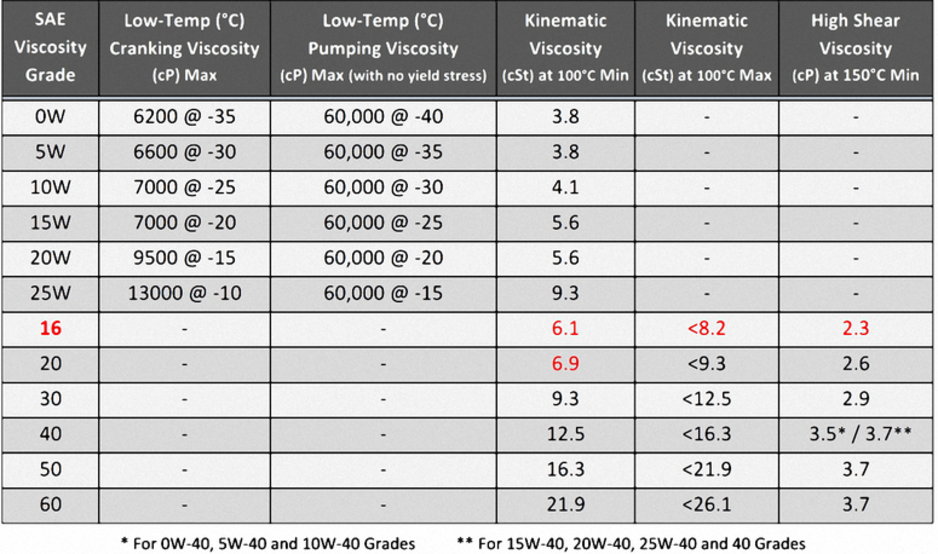
The SAE grade numbers are determined by the specific kinematic viscosityrange (measured at 100°C) that a particular oil falls into. For example, a motor oil that has a kinematic viscosity of 10.4 cSt at 100°C will be classified as an SAE 30 grade oil since it falls within its viscosity range of 9.3 cSt to 12.5 cSt.
For the high-temp viscosity grades, both minimum and maximum kinematic viscosity limits are given. However, for the low-temperature (“W”) grades, only the minimum kinematic viscosity limit is given because these grade numbers are primarily determined by the Low-Temperature Cranking and Low-Temperature Pumping (apparent)* viscosity measured at a specified temperature and shear rate.
* The Apparent Viscosity (AV) of a fluid, usually reported in units of centipoise (cP), is dependent upon shear conditions. The apparent viscosity changes with the rate of shear (e.g. apparent viscosity decreases as shear rate increases). Therefore, the shear conditions need to be specified in order to calculate the apparent viscosity measurements at a given temperature. (For more on the apparent viscosity of a fluid, see: Newtonian vs. Non-Newtonian)
Cold Cranking Viscosity (CCV) affects the startability of engines in cold temperatures. Low cold cranking viscosities make for easier cold temperature cranking and starting, resulting in less engine wear and less drain on the battery.The Cold-Cranking Testdetermines if an engine can be cranked over fast enough to start under extreme cold ambient conditions. Cold Cranking viscosity is determined by using a Cold-Cranking Simulator (CCS).
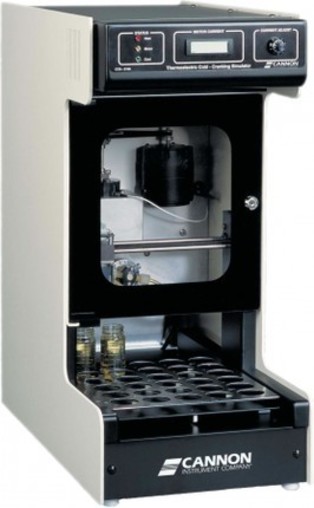
A Cold-Cranking Simulator simulates an oil's cranking resistance when cold, such as the viscosity of an oil in crankshaft bearings during start up on a cold winter morning, thus indicating the lowest temperature at which an engine is likely to start. The resulting ‘apparent’ viscosity is measured at a specified temperature and shear rate and is usually reported in units of centipoise (cP).
Cold PumpingViscosity measures the resistance of an oil to pumping through the engine after a cold start. If an oil's viscosity becomes too high (if the oil is too thick), pumping will be hindered with possible cavitation issues. Viscosity here becomes an important factor in determining whether the engine runs with sufficient lubrication after starting in severe cold conditions.
From an engine durability perspective, the most important low temperature oil performance issue is pumping, to ensure that the oil can circulate after the engine fires. Oil that is too thick in these conditions can cause oil starvation which could result in significant wear in critical engine parts.
The Cold Pumpability test is always conducted at 5°C colder than the Cold Cranking test to ensure the pump can deliver the oil to the bearings. Cold Pumping viscosity is determined by using a Mini-Rotary Viscometer (MRV).
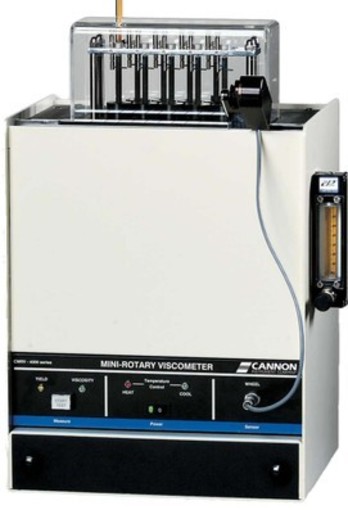
In this test method, oil is cooled slowly through a temperature range in which wax crystallization is known to occur, followed by rapid cooling to the final test temperature. The resulting ‘apparent’ viscosity is measured and is reported in units of centipoise (cP).
Correlations have been found between lack of pumpability in real field applications and failures in this test. These failures in the field are thought to be the result of the oil forming a gel structure that results in excessive yield stress or viscosity of the engine oil, or both.
High-temperature/High-shear (HT/HS) Viscosity (measured at 150°C) is a measure of an oil's ability to retain its viscosity and resist shearing when an engine is operating under load at high-temperatures (in severe service conditions).
An oil that is too thin under these conditions may not provide the needed lubricant protection, which could result in significant wear in these critical engine parts.An oil’s film thickness can be severely affected when an engine is exposed to high temperatures and the high shearing forces that are created when an engine is operating under load. These high temperatures and shearing forces can cause an oil to thin out and lose its load carrying ability.
The oil’s apparent viscosity varies inversely with the rate of shear to which it has been subjected to, that is, as the rate of shear increases, the viscosity of the oil decreases (referred to as shear-thinning).
The HT/HS Viscosity test is designed to determine the apparent viscosity of an oil under conditions of high shear at high temperatures. The resulting viscosity, measured at 150°C, is usually reported in units of centipoise (cP) and is determined by using a High-Temperature High-Shear Capillary Viscometer.
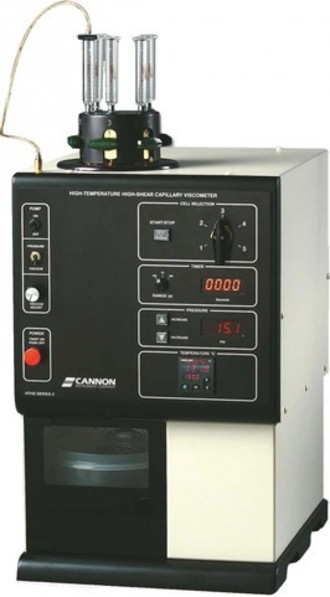
Oil Grade Numbers
The Oil Viscosity Grade Numbers (e.g. the 10W and the 30 in 10W-30 multigrade oil – sometimes referred to as the “weight” of the oil) are a rating representing the viscosity range and the viscosity limits of the oil. They are NOT the actual viscosity of the oil.
As mentioned above, the viscosity of oil is temperature dependent. In other words, a particular grade of oil will have a different viscosity/thickness at different temperatures; and since viscosity varies with temperature, the temperature must be clearly specified in order to interpret the viscosity reading.
For example, let’s look at a 30 grade oil and how the viscosity of this grade of oil varies with temperature. At normal operating temperatures (100°C) it has a kinematic viscosity* of around 10 cSt (centistokes) – which is optimal for most engines. But at 24°C (room/ambient temperature), it has a viscosity of around 250 cSt (which is way too thick).
Now let's consider a 10W grade oil and how the viscosity of this grade of oil varies with temperature. At normal operating temperatures (100°C) it has a viscosity of around 5 cSt (way too thin for a modern engine). But at 24°C, it has a viscosity of around 30 cSt (a lot better than 250).
In other words, what this means is that a 30 grade oil has pretty close to an ideal viscosity (around 10 cSt) at operating temperatures but is way too thick when cold (around 250 cSt) whereas a 10W grade oil has a more acceptable/desirable viscosity (around 30 cSt) when cold but is way too thin (around 5 cSt) at operating temperatures.
* Again, kinematic viscosity is the amount of time, in centistokes (mm2/s), that it takes for a specified volume of lubricant to flow, under the force of gravity, through a fixed diameter orifice at a given temperature.
Multi-grade Oils
In order to address this problem, oil companies, in the 1940s, came up with Multi-grade oils (sometimes described as all-season oils). The benefits of multi-grade (or multigrade) oils when starting the engine at lower temperatures was immediately apparent to many car owners and the popularity of these engine oils grew rapidly.
Multi-grade oils made it possible for an oil to meet both the low-temperature and the high-temperature grade specs. Let's use a conventional (mineral based) SAE 10W-30 multigrade oil as our example.
Because a 10W grade oil becomes way too thin at normal operating temperatures (having a viscosity of around 5 cSt when it should be around 10 cSt) what the oil companies did to solve this problem is add Viscosity Index Improversto it to prevent it from thinning as much as it normally would as it gets hotter. In other words, VII slow down the rate at which oil thins out as the temperature rises.
Now instead of having a viscosity of around 5 cSt when hot, it now has a viscosity of about 10 cSt (the same as an SAE 30). It still remains a 10W grade oil but now behaves like a 30 grade oil when hot.
Viscosity Index Improvers (VII) are large oil-soluble polymers made up of long-chain flexible molecules sometimes referred to as Viscosity Modifiers (VM). An example of a VII is an Olefin Co-polymer (OCP) which is a co-polymer of ethylene and propylene. A Polymethacrylate (PMA) is another example.
VII polymers expand and contract as temperatures vary. High temperatures cause VII to expand and reduce oil thinning; low temps cause VII to contract and have little impact on oil viscosity (see illustration below).
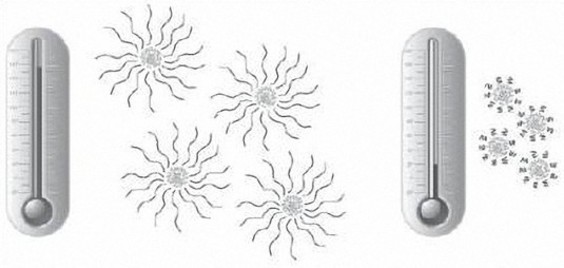
Viscosity Index Improvers come in different shapes, sizes and quality levels (i.e. some polymer chemistries are better thickeners than others). Generally speaking, larger molecules are better thickeners than smaller ones; however, they are also more easily broken, which impacts the shear stability of the oil (see following section).
To make sure the VII is used in the most cost-effective way, polymer thickening efficiency is also important. Thickening Efficiency (TE) describes the boost in Kinematic Viscosity at 100°C of an oil following the addition of a specific amount of polymer. A polymer having a high TE indicates that it is a potent thickener. TE is primarily a function of polymer chemistry and molecular weight.
The downside to mineral-based multigrade oils is that they require a lot more VII in order to meet the proper viscosity requirements. Problem is, the VII additive wears out (shears) over time, effectively reducing the oil’s viscosity, until the oil becomes too thin to provide adequate protection (which is one of the reasons it needs to be changed more often than synthetic oil).
Synthetic oils on the other hand, such as AMSOIL lubricants, have a much higher native viscosity index than conventional oils and therefore need much lower levels of VII additive (in some cases, none at all) to increase their viscosity to the desired levels. As a result, they are able to maintain their viscosity for a much longer period of time and therefore don’t need to be changed as often.
Viscosity Shear Stability
Oil experiences very high stresses in certain areas of the engine such as in the oil pump, cam shaft area, piston rings, and any other area where two mating surfaces squeeze the oil film out momentarily.
An oil’s viscosity can be severely affected when an engine is exposed to high temperatures and the high shearing forces that are created when an engine is operating under load. These high temperatures and shearing forces can cause an oil to thin out and lose its load carrying ability, resulting in engine wear.
The oil’s viscosity varies inversely with the rate of shear to which it has been subjected to, that is, as the rate of shear increases, the viscosity of the oil decreases.
As previously mentioned, multigrade engine oils contain Viscosity Index Improvers (VII) which are made-up of very large “viscosity-altering” oil-soluble molecules also known as Viscosity Modifiers (VM). As they are heated, these large flexible polymer molecules uncoil and spread out. Their many “branches” entangle with those of other polymer molecules and trap and control many tiny oil molecules.
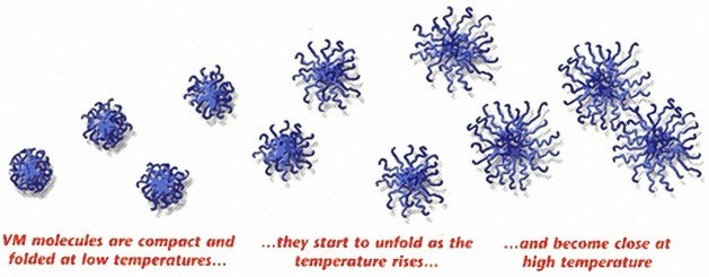
As oil is squeezed between two mating surfaces, such as between a bearing and a journal, VII polymer molecules, or coils, have a tendency to align with each other and get “squashed”. This causes the polymer coil to deform (elongate/stretch) and become aligned to the direction of flow. When this happens, viscosity temporarily drops resulting in oil film thickness reduction. After the oil progresses through the bearing, the polymer coils “spring back” to their original shape and viscosity returns to normal. This phenomenon is referred to as temporary shear-thinning.
In certain high shear conditions, the long flexible polymer chains can be ruptured or pulled/ripped apart (molecular scission) into smaller chains. When the shearing force is removed, the broken polymer chains cannot re-form into the single large chain because the coil has been physically and chemically changed. Consequently, this causes the oil to permanently lose viscosity leading to a reduction of oil film thickness which can lead to oil film failure and an increase in engine wear. For example, an SAE 5W-30 oil can ‘shear back’ to an SAE 5W-20 oil or worse, resulting in damaging deposits, increased wear, and reduced engine life. This phenomenon is referred to as permanent shear-thinning.
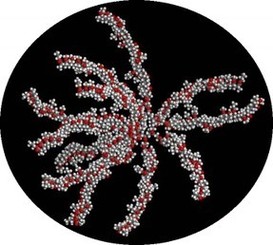
The ability of an oil to resist these shearing forces is called Shear Stability.
Shear Stability is a measure of the resistance of an oil to changes in viscosity caused by the oil being subjected to mechanical stress or shear. The outcome of this mechanical shear is a reduction in viscosity resulting in reduced oil film thickness allowing the possibility of metal to metal contact.
Needless to say, an oil’s shear stability – its ability to retain its viscosity in High-Temperature/High-Shear (HT/HS) conditions – is essential in maintaining an adequate oil film thickness between moving surfaces, effectively preventing metal to metal contact. Viscosity retention of multi-grade oils is an important performance characteristic since adequate oil film thickness is required for engine wear protection.
VII polymers having higher molecular weight have a greater propensity for polymer coil breakage. In other words, while large molecules are better thickeners then smaller ones, they are also more easily broken, which impacts the shear stability of the oil.
Moreover, different VII polymers have different shear stability characteristics, depending on their molecular weight and chemical nature, and come with different Shear Stability Indexes that reflects their quality and capability to resist permanent viscosity loss.
A polymer’s Shear Stability Index (SSI) is defined as its resistance to mechanical degradation (polymer coil breakage) under shearing stress; the lower the polymer’s SSI the better the finished oil’s ability to resist shear and suffer permanent viscosity loss.
The “Kurt Orbahn Diesel Injector Test”is a frequently used test to quantify permanent shear stability. It measures the permanent reduction in an oil’s viscosity after 30 cycles through the test apparatus.
The oil’s viscosity falls during the test due to polymer coil breakage. In other words, only that part of the oil’s viscosity which is contributed by the VII polymer is susceptible to breakage. Neither the base oil nor the additive performance package suffers permanent viscosity loss.
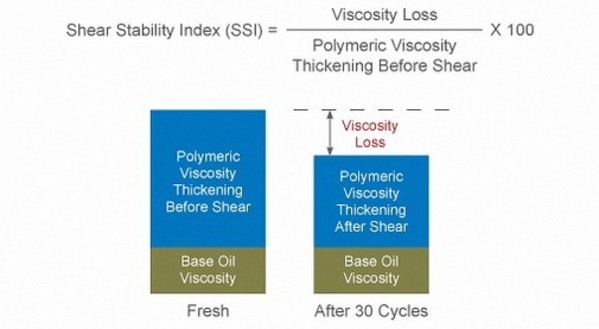
For example, an oil is formulated with a base oil viscosity of 5 cSt (at 100°C) and a VII is used to increase its viscosity to 15 cSt. The VII’s viscosity contribution is therefore 10 cSt. During the shear test, the oil’s viscosity falls to 12 cSt. It has permanently lost 3 cSt of viscosity. The VII polymer’s ‘Shear Stability Index’ (SSI) is therefore 3 cSt (loss) divided by 10 cSt (VII contribution), or 30% SSI.
Synthetic oils have a much higher native viscosity index than conventional oils and therefore do not rely as much on “polymeric thickeners” to attain their desired viscosities. As a result, they experience very little viscosity loss due to shearing making them very shear stableand able to better protect and remain ‘in-grade’ much longer.
AMSOIL’s 100% Synthetic Signature Series Motor Oils, for instance, are formulated using the industry's most advanced synthetic base stocks and additive packages allowing them to significantly outperform and outlast conventional oils and most other synthetic oils. (They’re also sugar free and low in fat J )
Check out my other Viscosity articles: Oil Viscosity: the Basics & Which Oil Viscosity Grade Should I Use In My Vehicle?
TWO DIFFERENT WAYS TO ORDER
1- Place your Order Online by following the LINKS on this website
2- Order by Phone: 1-800-777-7094 (mention referral # 5256323)
__
POWER BIG SAVINGS WITH A PREFERRED CUSTOMER MEMBERSHIP
Register
as an AMSOIL Preferred Customer to receive:



